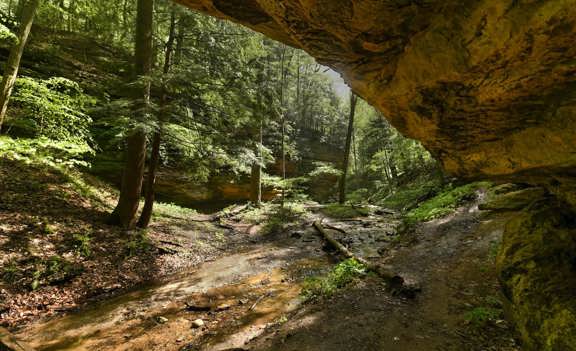
For dog owners, traveling with their four-legged friends is often a top priority. Exploring the great outdoors can be an exhilarating experience, especially when you can share it with your canine companion. National parks offer some of the most stunning landscapes in the country, but the rules from the National Park Service regarding pets can be a bit confusing.
This blog aims to clarify whether dogs are allowed in national parks, discuss the regulations around service dogs, recommend dog-friendly parks, and offer tips for a smooth visit.
Finally, we'll highlight how Cruise America RV rentals accommodate dog owners, making it easier to plan your adventure.
Are Dogs Allowed in National Parks?
The short answer is yes, dogs are allowed in national parks, but with significant restrictions. Generally, pets are permitted in developed areas, on many developed campgrounds, and on some trails that are close to these areas. However, each national park has its own specific regulations based on the need to protect wildlife, the natural environment, and the safety of all visitors — including pets.
For instance, in Yellowstone National Park, pets are allowed but must be kept on a leash no longer than six feet at all times. They can only go where vehicles can go: roads, parking areas, picnic areas, and campgrounds. Pets are not allowed on trails or in the backcountry. This is fairly typical of most national parks’ regulations.
Why Aren’t Dogs Allowed in Some Areas?
The primary reason dogs are restricted from certain areas within national parks is to protect wildlife and the natural habitat. Leashed dogs can chase wildlife, disturb ecosystems, and introduce diseases. Additionally, pets in national parks can lead to potentially dangerous wildlife encounters. Bears, coyotes, and other animals may react aggressively if a dog enters their territory.
Moreover, some trails or areas within national parks are considered particularly sensitive environments, like wetlands or regions with rare plant species. Leashed dogs, even when well-behaved, can disrupt these habitats. Park authorities impose restrictions to ensure the ecosystems in official wilderness areas remain intact and the wildlife undisturbed.
Regulations Around Service Dogs
Service dogs are an exception to most pet restrictions in national parks. Under the Americans with Disabilities Act (ADA), service dogs are allowed in more areas than pets. This includes trails and backcountry areas where pets are generally not permitted. Service dogs must be under control at all times, and park visitors with service dogs are encouraged to check specific park regulations before their visit, as guidelines can vary slightly from one park to another.
Individuals with service dogs are encouraged to check specific park regulations before their visit, as guidelines can vary slightly from one park to another. National parks strive to accommodate visitors with disabilities while also preserving the park’s resources, so knowing the regulations beforehand can help ensure a safe and enjoyable visit for everyone involved
Understanding these regulations helps ensure that all visitors — including those with furry companions — can enjoy the beauty and serenity of America’s national parks safely and responsibly.

Top Dog-Friendly National Parks
While restrictions exist, there are several national parks known for their dog-friendly policies. Here are a few top pet-friendly national parks:
-
Acadia National Park, Maine: Offers 100 miles of hiking trails and 45 miles of carriage roads where leashed pets are allowed.
-
Shenandoah National Park, Virginia: More than 480 miles of pet-friendly trails where dogs can explore with their owners.
-
Grand Canyon National Park, Arizona: Pets are allowed on trails above the rim, making it a fantastic option for breathtaking views.
-
Cuyahoga Valley National Park, Ohio: Pets can join you on the Towpath Trail and several other paths throughout the park.
-
Yosemite National Park, California: While pets are not allowed on most of the trails, they can enjoy all paved paths, which include some scenic views of Yosemite’s famous landmarks like Yosemite Falls and Half Dome. This makes it a great option for those wanting to enjoy some of the park’s beauty without straying from developed areas.
-
Petrified Forest National Park, Arizona: This park is unique as it allows pets almost everywhere outdoors — on trails, in the wilderness areas, and along the roads. This makes it an excellent spot for pet owners who want to explore diverse landscapes, from colorful badlands to vast grasslands.
-
Hot Springs National Park, Arkansas: This urban park is centered around the town of Hot Springs, where dogs are allowed on all the trails. It’s a great mix of natural beauty and historical significance, with the added convenience of easy access to town amenities.
-
Congaree National Park, South Carolina: Known for its towering hardwoods and expansive swampy areas, Congaree allows pets on many trails and in the campground, provided they are on a leash. This park offers a truly immersive nature experience, perfect for dogs that are comfortable in more rustic and wild settings.
-
White Sands National Park, New Mexico: This park offers a striking landscape of white gypsum sand dunes where pets are welcome on a leash. Exploring the dunes with your dog can be a surreal experience, akin to walking on another planet. It's a unique spot for pets and owners alike to experience vast open spaces and incredible sunsets.
These parks not only provide great exercise and exploration opportunities but also feature stunning natural beauty that can be enjoyed alongside your dog.
Tips for Bringing Your Dog to a National Park
To ensure a safe and enjoyable trip with your dog to a national park, consider the following tips:
-
Check Specific Park Rules: Before heading out, look up the specific regulations for the park you plan to visit. This will help you avoid any surprises and ensure you’re prepared. Feel free to talk to a park ranger to ask any specific questions.
-
Keep Your Dog Leashed: Always keep your dog on a leash where required. This protects them, the wildlife, and other visitors.
-
Bring Water and Waste Bags: Ensure you have plenty of water for both you and your pet, and bring dog waste bags to keep the park clean. Properly disposing of your pet's waste keeps the park beautiful for all visitors.
-
Consider Your Dog’s Abilities: Not all dogs are suited for long hikes. Consider your pet’s age, health, and fitness level when planning your activities.
Traveling to national parks with your dog can be a fantastic experience if you're prepared and understand the regulations. By choosing dog-friendly parks and following the guidelines, you can enjoy a stress-free adventure in nature. With companies like Cruise America offering dog-friendly RV rentals, planning your next national park visit with your pet has never been easier.
Cruise America: A Dog-Friendly RV Experience
When planning a trip to a national park with your dog, consider renting an RV from Cruise America. Our rentals are dog-friendly and offer a comfortable and flexible way to explore. With an RV, you can keep your pet's food, water, and bed handy, making the travel experience better for them and easier for you.
For more insights and tips on traveling with pets, check out other dog-related blogs on our website. These resources can help you plan a pet-friendly vacation, ensuring that both you and your dog have an enjoyable time exploring the great outdoors on your road trip.
So pack your bags (and dog bowls) and set off on an adventure you and your furry friend will never forget!

